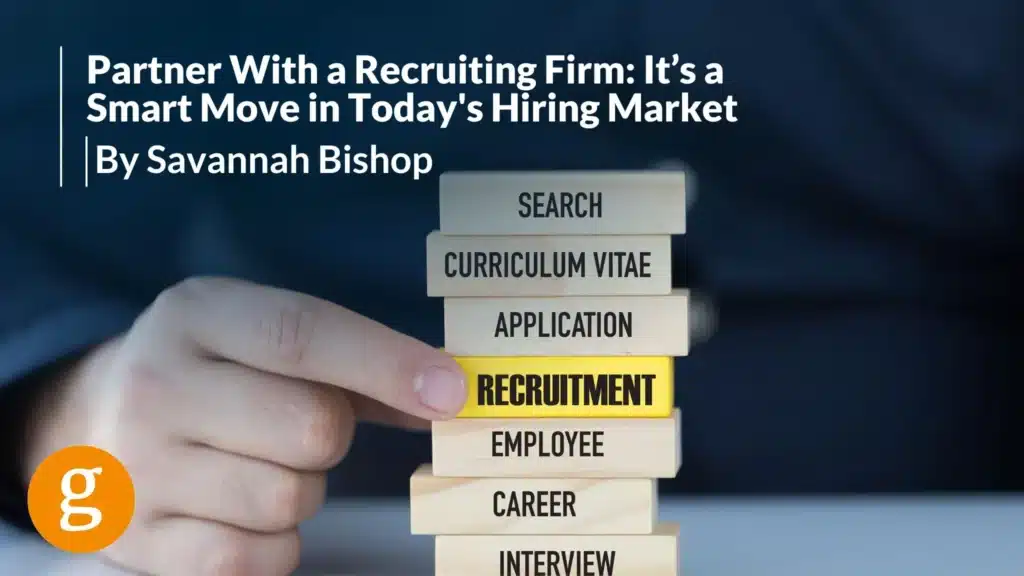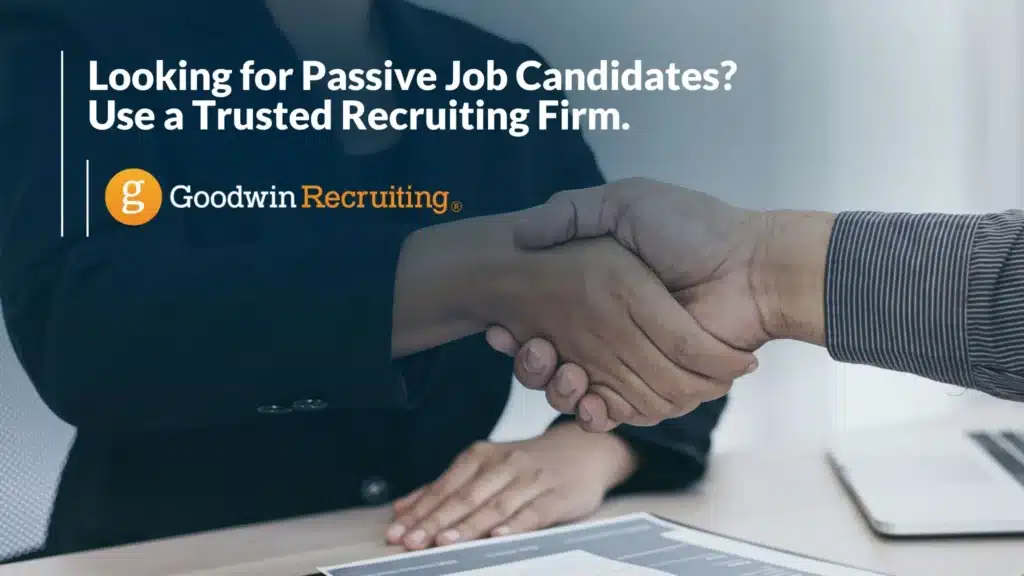New Ways to Attract Top Talent in a Competitive Hiring Market
Goodwin Recruiting | Hiring Advice | July 15, 2021

The current U.S. employment landscape is a contradiction. Unemployment is relatively high, yet companies nationwide are struggling to find talent. Vaccine rates continue to climb, and pandemic restrictions everywhere are lifting, but people remain hesitant to return to the workplace. The economy continues to open up with demand returning to pre-pandemic levels, but supply is not rebounding as quickly, due in large part to a lack of skilled labor.
“Our clients, along with companies around the world, are feeling the pain of being short-staffed,” says Goodwin Recruiting Client Relationship Manager Jenny Battershell. “It’s a candidate’s market right now. We have candidates who are looking one day and hired the next, having received four+ job offers in one week’s time. We’re also seeing multi-unit and corporate-level leaders working to close gaps in hourly roles that they simply cannot find candidates to fill.”
“It is a top priority of ours to work with clients to inspire new ideas, new perks to offer, and new ways to make their company culture stand out. Strategies are working,” Battershell added.
Severe circumstances call for extraordinary measures
Brent Orrell, Resident Fellow at the American Enterprise Institute, says there is “little precedent for – and lots of confusion about – the employment situation,” citing statistics from the June 8 Job Openings and Labor Turnover Summary from the U.S. Bureau of Labor Statistics.
“What the statistics show – at least through April,” Orrell says, “is a strange labor market brew of post-pandemic elevated unemployment, rising wages and incentives for historically low-wage jobs, and high job turnover. These conditions are disorienting because they have probably never occurred simultaneously in the memory of most people living today, if ever.”
Despite the talent crisis, the show must go on, and employers are pulling out the stops to meet essential hiring goals in today’s extraordinarily competitive hiring market.
These strategies “would have been unimaginable 18 months ago”
That’s how Orrell describes the wage increases and incentives businesses are using to compete for the best job candidates amid the talent shortage and retain existing staff. Although some are not new, the number of companies employing them is mounting and employers already using them are increasing previous levels and offerings.
CNN recently reported how America’s stores are turning to a particular incentive less commonly deployed in the retail industry – sign-on bonuses for new hires – sharing how Amazon (AMZN), Ollie’s Bargain Outlet (OLLI), Tops Markets supermarket chain, Sheetz convenience stores, and many smaller stores are offering such one-time payments to sweeten job offers to new workers.
In the hospitality industry, extremely hard hit by the talent crisis, restaurants are offering up creative incentives, perks, and sign-on bonuses to get applicants in the door and prevent staff attrition. Free hotel rooms for summer employees are among a range of incentives offered by Omni Hotels & Resorts, and new employees receive three free nights at their Omni of choice.
“We have never taken guest rooms out of inventory for housing before,” says Joy Rothschild, Omni’s chief Human Resources officer, who says the incentives being offered are needed to fill the ranks.” If anything, she said, new incentives are on the way. “We want to see how much traction we get with these, but I suspect we will be coming out with more.”
Across industries, the types and volume of incentives and benefits offered by employers are growing by the day:
- Higher wages and more compelling compensation and benefits packages
- College tuition, scholarship programs, and educational benefits for family members
- Company-sponsored certifications, skills training, and management training programs
- Apprenticeship programs (particularly in the manufacturing industry)
- Three- and four-figure sign-on bonuses – and performance bonuses and incentives
- Greater promotion and advancement opportunities
- Flexible work-from-home (WFH) policies
- New hybrid working models (part remote, part on-site)
- More flexible working hours to reduce commute times and increase work-life balance
- Relocation allowances
- Relaxed job requirements to expand the pool of available talent
- Stronger diversity and inclusion initiatives for more equitable opportunities and workplaces
- Health and wellness perks (gym memberships, fitness trackers, pet insurance discounts)
- Paid family, medical, maternity, and paternity leave
- Free hotel rooms and other accommodations
- Rewards and incentives just for turning up for job interviews
- iPhones
- Free meals
Companies are getting creative in their pursuit of new employees. And it’s working.
What we’re seeing at Goodwin Recruiting
Some clients of Goodwin Recruiting have been successful in offering robust signing bonuses and relocation packages to onboard top-performing candidates. Here are a few examples:
- $1,000 signing bonus when hired, paid at 60 days
- $3,000 signing bonus split into three parts: $1,000 after training, $1,000 at six months, and $1,000 at one year
- $10,000 signing bonus split into two parts: $5,000 after completing manager training, and $5,000 at six months
“Some of our clients are also offering relocation allowances,” Battershell said. “A common one is relocation compensation up to $5,000, split into two parts, with half paid on the candidate’s starting date and the other half after 90 days with the company.”
Battershell said clients are also enjoying faster hires by opting for Retained Searches for talent recruitment, which provide a select number of highly qualified candidates and longer placement guarantees. “Retained search is a great method when clients have an essential or time-sensitive talent need and want to elevate the search to priority status,” she says.
The top five fastest-growing voluntary benefits
In addition to the talent acquisition incentives emerging in abundance across industries, companies are also increasing their voluntary benefits, or supplemental benefits, which employees can choose to purchase through their employers.
According to Willis Towers Watson (NASDAQ: WLTW), a global advisory, broking, and solutions company, the pandemic is driving more employers to offer voluntary benefits to address new trends, better meet the needs of a diverse workforce, and attract and retain talent.
The company’s 2021 Emerging Trends in Health Care Survey earlier this year included a section on voluntary benefits, which received responses from 238 employers representing 3.7 million workers. Survey results found the following voluntary offerings among the most widespread benefits, services, and perks employers currently offer or are planning to offer over the next two years:
- Financial planning/counseling through an existing vendor (93%)
- Tuition reimbursement programs (88%)
- Telephonic financial planning/counseling (77%)
- Onsite fitness center (54%)
- Backup childcare (48%)
- Elder care (44%)
More ways to increase your hiring success
- Look past the stigma of employment gaps: Carl Van Horn, director of the John J. Heldrich Center for Workforce Development at Rutgers University, believes long-term unemployment still carries a stigma, even during the health crisis. But economists and staffing experts believe it is different as a result of the pandemic, particularly with job seekers who have improved their skills during protracted unemployment.
For example, Rishi Khanna, CEO of ISHIR, a Dallas-based software company, recently hired a software developer who had been out of work since September. “Before the pandemic, we would have been very unsure,” Khanna says. But he says he felt more confident because the candidate had taken three online courses in software development and project management. “Once we saw he was investing time upgrading his skills, we were more comfortable,” he says.
- Don’t drag out the process: While making the right hire is of the utmost importance, in today’s climate, the longer you wait, the more likely the “right hire” is to accept another offer or go another direction. While it varies by industry, we often recommend an interview to hire process of 10 days or less. The faster companies can get candidates through the interview process, the less likely they are to find opportunities elsewhere.
- Invest in employee training: Although workers hold the cards today, no trend lasts forever, and people know they must continually increase their skills to remain competitive in the job market. Thus, workers are looking for companies that upskill and reskill their people, and provide development opportunities through paid certifications, education, and management programs. Not surprisingly, these employers are doing better in today’s hiring market and enjoying greater business success.
- Remember your culture is worth its weight in employee gold: Many businesses do not realize that their company cultures may be working against them in today’s hiring market. A study from Glassdoor shows that attracting and retaining talent involves more than compensation and benefits:
- When searching for a new job, 77% of respondents said they would consider a company’s culture before applying.
- American Millennials are more likely to care about work culture over salary (65%).
- 89% of adults polled told researchers it was important for employers to “have a clear mission and purpose.”
Overcoming hiring challenges is easier and faster with a recruiting partner
Across the country, recruiting specialists are in overdrive, making a big difference in helping employers bridge critical talent gaps. “HR managers are short-staffed and monopolized in filling mission-critical roles. There’s no question they are benefitting from the expertise and speed of professional recruiters in finding top talent fast, including passive candidates,” Battershell says.
Ranked one of the United States’ best executive and professional recruiting firms, Goodwin Recruiting is working with employers across a broad range of industries nationwide to fill essential roles, from executives to operators and managers.
Share This Article






































